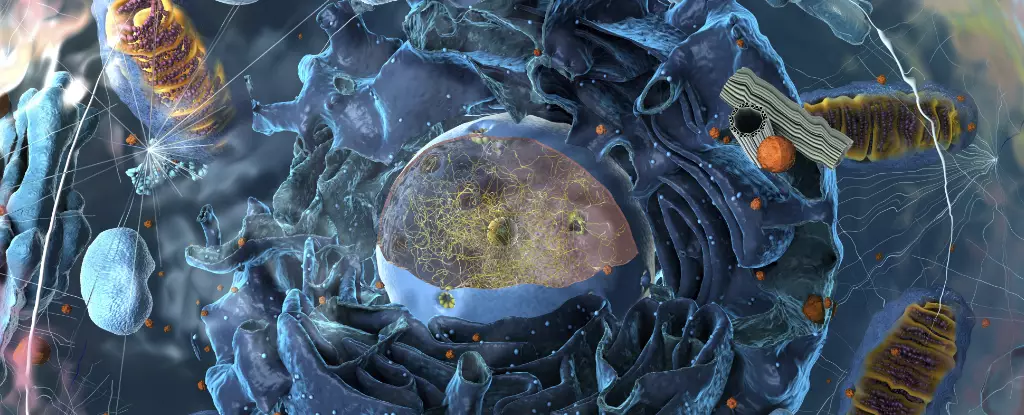In the realm of biology, our understanding of cellular mechanics has undergone a radical transformation. High school students may recall the classic definition of organelles: membrane-bound structures within cells, each responsible for specific tasks essential to cellular function. This paradigm, long held as the norm in cell biology, has been challenged by the emergence of membraneless organelles, or biomolecular condensates, which have brought forth a wave of reconsideration regarding our comprehension of cellular organization and function.
In the mid-2000s, scientists began to recognize that not all cellular compartments required the presence of a membrane. This pivotal realization has led to the discovery of various membraneless organelles that are potentially reshaping our understanding of life’s origins and the intricate chemistry within cells. What once seemed to be a simple landscape of organelles has revealed itself as a dynamic and complex environment where biochemical processes may unfold in novel ways, opening exciting new avenues for research and exploration.
To visualize the concept of biomolecular condensates, consider the playful imagery of a lava lamp. The mesmerizing dance of wax blobs as they fuse, break apart, and recombine serves as a fitting analogy for how these condensed structures operate within cells. Rather than wax, biomolecular condensates form from clusters of proteins and RNA molecules, coalescing into gel-like droplets. These droplets arise from specific interactions between proteins and RNA that favor association with one another over the surrounding cellular environment, creating unique microenvironments that foster interactions critical for various cellular functions.
Since their recognition, the scientific community has identified around 30 distinct types of these biomolecular condensates, which surpass the dozen or so traditional membrane-bound organelles. What remains enigmatic, however, is the precise roles of many of these condensates. While some, like ribosomal units or stress granules, exhibit clear functions in the cell, the significance of others remains elusive. This discrepancy begs further investigation into their potential roles and how they might impact cellular processes in a way that differs fundamentally from traditional organelles.
The emergence of biomolecular condensates has shaken the longstanding dogma that a protein’s structure directly dictates its function. Historically, biochemists held that well-defined protein structures were essential for their functional capabilities. This notion was built upon foundational discoveries in the 1950s, typified by the structural insights into myoglobin and its essential role in oxygen transport in muscles.
However, uncovering the existence of intrinsically disordered proteins (IDPs) challenged this binary understanding of protein function. These proteins lack a stable structure yet can still perform specific roles within the cell, often integrating into condensates. This revelation has complicated the biological narrative surrounding protein function, necessitating a reevaluation of how we conceptualize molecular interactions within cells.
Further complicating matters, research has shown that biomolecular condensates are not exclusive to eukaryotic cells; they are also present in prokaryotic organisms such as bacteria. The idea that these simpler forms of life might harbor such sophisticated structures adds a layer of complexity to our perception of bacterial biology. Traditionally viewed as mere cellular bags devoid of organelles, bacteria are now understood to possess a rich and intricate organizational system that may rival the complexity found in more advanced organisms.
The implications of these findings reach far beyond cellular structure and function; they touch upon the very origins of life itself. Current evidence suggests that the building blocks of RNA and DNA, nucleotides, could originate from simple chemical reactions occurring under early Earth conditions. Coupled with this is the RNA world hypothesis, which posits that RNA molecules were among the first forms of life. The conventional notion that lipid membranes are required for the formation of early protocells is challenged by the existence of RNA-driven biomolecular condensates.
If RNA molecules can create these condensates independently, the prospect that life emerged from nonliving chemical processes becomes increasingly plausible. This insight pushes the boundaries of our understanding and invites fresh inquiries into how life, as we know it, evolved from the primordial soup of early Earth.
As we continue to explore the diverse roles of biomolecular condensates, their importance also extends to potential medical applications. Conditions like Alzheimer’s disease, Huntington’s disease, and Amyotrophic Lateral Sclerosis (ALS) have been linked to dysfunctional protein aggregates. Understanding how to manipulate these condensates could pave the way for innovative therapies aimed at combating these devastating illnesses.
Researchers are already investigating techniques to promote or dissolve these condensates, opening new pathways for drug development. As our grasp of biomolecular condensates deepens, it is likely each will be associated with specific pathways and functions, ultimately enriching the curriculum of future biology students.
Our exploration of biomolecular condensates signals a significant shift in biological research, inviting a rethinking of previously established dogmas. As scientists unveil the mysteries of these unique structures, we stand on the cusp of groundbreaking discoveries that could reshape our understanding of cell biology and the very nature of life itself. The excitement surrounding this new frontier in science is palpable, promising a wealth of opportunities for future inquiry and innovation.


Leave a Reply